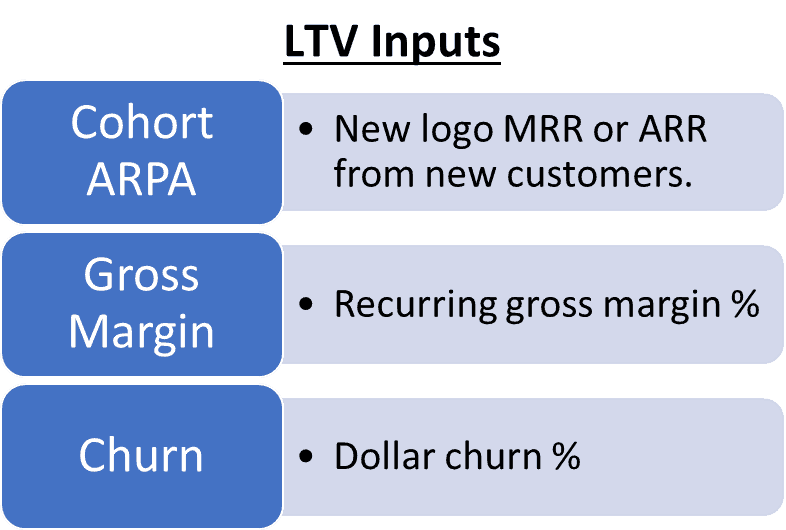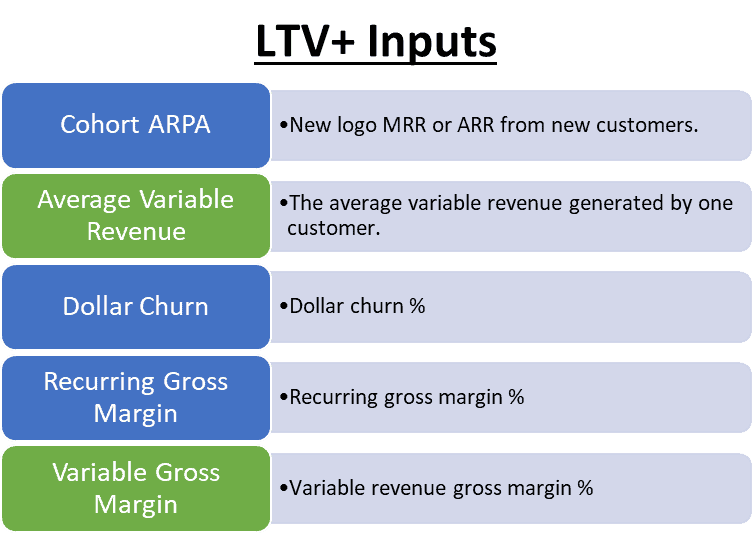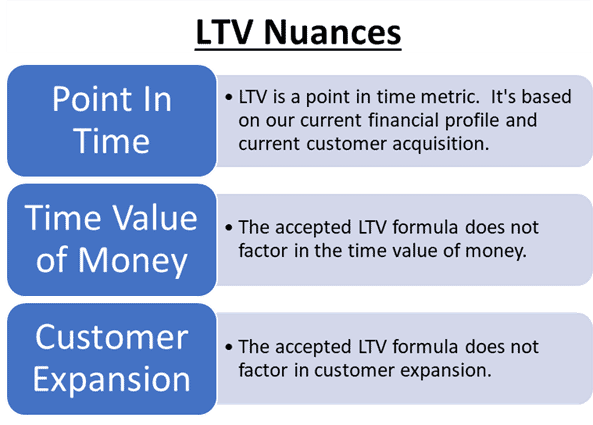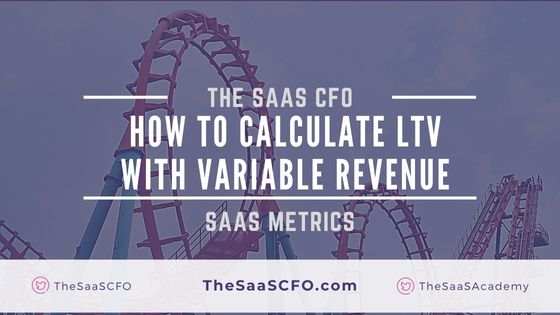SaaS revenue models are changing, and so should our SaaS metrics. A SaaS founder emailed me recently about the customer lifetime value metric. His SaaS company has significant usage revenue in addition to traditional subscription MRR. However, traditional SaaS metrics are commonly set up for just one revenue stream.
Customer lifetime value (LTV or CLTV) is a ubiquitous SaaS metric. If you have significant variable revenue streams, we must modify the formula to account for this. Variable revenue streams might include usage, processing, and/or transaction revenue lines.
In this post, I’ll breakdown lifetime value and lifetime value with variable revenue (LTV+). You can also download the free Excel template below.
What is Customer Lifetime Value (LTV)
Customer lifetime value is the revenue or margin that you receive from one customer over the lifetime of that customer. The term “Customer Lifetime Value” is known by many words. It’s also known as LTV or CLTV.
LTV is an important concept in SaaS. LTV by itself does not mean much. You must compare LTV to CAC (customer acquisition costs) for it to have true meaning in your SaaS business.
When we compare LTV to CAC, we are trying to understand the balance between upfront customer acquisition costs and LTV. If LTV equals CAC, we never make money on that customer. In fact, our company will burn cash because we must still cover other expenses in our business such as R&D and G&A.
The LTV to CAC rule of thumb is 3x. We want our LTV to be at least three times our CAC. The higher, the better.
The Traditional Lifetime Value Formula
The widely used LTV formula requires three inputs: cohort ARPA, gross margin, and dollar churn. For gross margin and churn, I like to use the trailing three to six months of data as a proxy for our current financial profile. Cohort ARPA can represent one month of acquisition or the trailing three if we don’t acquire many customers (enterprise setting).
When we gross margin adjust LTV, LTV is reduced by the direct expenses in COGS that are necessary to deliver our revenue.
That’s why I like describing LTV as the cash flows from our customers. The cash flow is then be used to cover our operating expenses (OpEx) which include R&D, sales, marketing, and G&A.


LTV Adjusted for Variable Revenue
Our traditional LTV formula above factors in only one revenue stream. Traditionally, this has been subscription-based. As our revenue streams expand, so does our new LTV+ formula.
To factor in variable revenue (usage, processing, transaction, etc.), we must include the margin-adjusted variable revenue in the numerator.
The variable revenue input is the average variable revenue received from one customer on a monthly or annual basis. Of course, variable revenue is variable! But we must estimate this amount.
It could be historical-based (average ARPA over the past 12 months) or contract-based (do we have minimum variable tiers in our contract?).
Be sure to be consistent with monthly or annual numbers in the LTV formula.


Customer Lifetime Value Example
Below I demonstrate a traditional LTV example and an LTV+ example. You can see that there is a huge difference in LTV if we forget significant variable revenue streams in the equation.
LTV Inputs
- $100 MRR – the monthly cohort ARPA from our most recent customer wins
- $300 Variable – the monthly average variable revenue that we receive from customer
- 1% Churn – the monthly dollar churn (I use 1 – Gross Dollar Retention)
- 80% – the gross margin percentage from our subscription revenue line
- 90% – the gross margin percentage from our variable revenue line


Customer Lifetime Value Nuances
A couple of things to remember with LTV. LTV is a point in time calculation. Meaning, next month your numbers may be different based on the performance of your business. For example, has your churn or gross margin profile changed?
The common LTV formula does not factor in the time value of money. My template below includes an advanced LTV formula which factors in time value of money.
The common LTV formula does not factor in customer expansion. My advanced formula factors in expansion but be careful when comparing to CAC. CAC traditionally measures new acquisition only. It does not factor in expansion costs.
Finally, I’m assuming churn is the same for variable revenue and subscription revenue. This is a difficult one because we know that variable revenue increases and decreases each month.

Action Items
First, review your revenue streams. Do you have subscription revenue only? Or do you have a mix of recurring revenue? If you have variable revenue streams that comprise more than 10% of your total revenue, you may want to use the LTV and LTV+ formula. Compare the difference in the results.
If you see material differences in the two LTV results, you may want to report both or LTV+ only.
Download my LTV+ Excel template below.
I have worked in finance and accounting for 25+ years. I’ve been a SaaS CFO for 9+ years and began my career in the FP&A function. I hold an active Tennessee CPA license and earned my undergraduate degree from the University of Colorado at Boulder and MBA from the University of Iowa. I offer coaching, fractional CFO services, and SaaS finance courses.


Hi Ben,
Thanks for sharing your thoughts on this topic. Variable revenue makes LTV tricky – especially when there are high monthly and quarterly fluctuations. You mentioned that your methodology above assumes the same churn rate for both subscription and variable revenue, but how would you approach reporting on a business that has materially different churn rates for subscription and variable revenue in one metric? I was also wondering what your opinion would be to only include variable revenue dollar churn for customers who also churned their subscription revenue, since the theoretical purpose of the churn rate is to represent the customer lifetime.
Thanks again!
Jubal